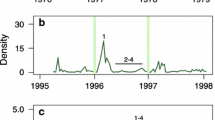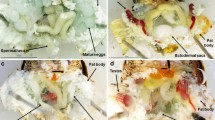Abstract
This study examines the optimal seasonal timing of the life cycle for univoltine and bivoltine insects, assuming that resource availability has a peak in the middle of a year and is symmetric around it. Results show that if the growth rate increases in proporrion to the bodyweight, bivoltine life cannot be optimal. If the growth rate is a power function of the bodyweight with a power smaller than unity, a symmetric bivoltine solution can be the optimal provided that the resource availability has a plateau in the middle of the season. If the resource availability has a sharp peak, the optimal pattern is an asymmetric bivoltine solution in which the larval periods of two generations differ in length. The bivoltine life cycle is more likely to be superior to the univoltine one if: growth is fast, suitable growing season is long, biomass loss during nonlarval stages is small, and egg size is small.
Similar content being viewed by others
References
Allee W. C., Emerson A. E., Park O., Park T. &Schmidt K. P. (1949)Principles of Animal Ecology. Saunders, Philadelphia, 837 pp.
Cohen D. (1970) A theoretical model for the optimal timing of diapause.Am. Nat. 104: 389–400.
Furunishi S. &Masaki S. (1982) Seasonal life cycle in two species of ant-lion (Neuroptera: Myrmeleontidae).Jpn. J. Ecol. 32: 7–13.
Iwasa Y. (1991) Asynchronous pupation of univoltine insects as the evolutionarily stable phenology.Res. Pop. Ecol. (in press).
Kidokoro T. &Masaki S. (1978) Photoperiodic response in relation to variance voltinism in the ground cricket,Pteronemobius fascipes Walker (Orthoptera: Gryllidae).Jpn. J. Ecol. 28: 291–8.
Kleiber M. (1961)The fire of life: an introduction to animal energetics. Wiley, New York, 454 pp.
Masaki S. (1978) Seasonal and latitudinal adaptations in the life cycle of crickets. In:The Evolution of Insect Migration and Diapause. (ed. H. Dingle) pp. 71–100. Springer-Verlag, New York.
Masaki S. (1980) Summer diapause.Ann. Rev. Entomol. 25: 1–25.
Roff D. (1980) Optimizing developmental time in a seasonal environment: ‘ups and downs’ of clinal variation.Oecologia 45: 202–8.
Schmidt-Nielsen K. (1984)Scaling: Why is Animal Size so Important? Cambridge University Press, Cambridge, 241 pp.
Shapiro A. M. (1975) The temporal components of butterfly species diversity. In:Ecology and Evolution of Communities. (eds M. L. Cody and J. M. Diamond), pp. 181–95. Belknap, Harvard.
Sota T. (1987) Mortality pattern and age structure in two carabid populations with different seasonal life cycles.Res. Popul. Ecol. 29: 237–54.
Sota T. (1988) Univoltine and bivoltine life cycles in insects: a model with density-dependent selection.Res. Popul. Ecol. 30: 134–44.
Sota T. (1990) Variation in voltinism of insects: an evolutionary ecological approach.Bull. Soc. Popul. Ecol. 46: 68–76 (in Japanese).
Tauber M. J., Tauber C. A. &Masaki S. (1986)Seasonal Adaptation of Insects. Oxford University Press, Oxford.
Taylor F. (1981) Ecology and evolution of physiological time in insects.Am. Nat. 117: 1–23.
Taylor F. (1986a) The fitness functions associated with diapause induction in arthropods. I. The effects of age structure.Theor. Popul. Biol. 30: 76–92.
Taylor F. (1986b) The fitness functions associated with diapause induction in arthropods. II. The effects of fecundity and survivorship on the optimum.Theor. Popul. Biol. 30: 93–110.
Author information
Authors and Affiliations
About this article
Cite this article
Iwasa, Y., Yamauchi, A. & Nozoe, S. Optimal seasonal timing of univoltine and bivoltine insects. Ecol. Res. 7, 55–62 (1992). https://doi.org/10.1007/BF02348597
Accepted:
Issue Date:
DOI: https://doi.org/10.1007/BF02348597




